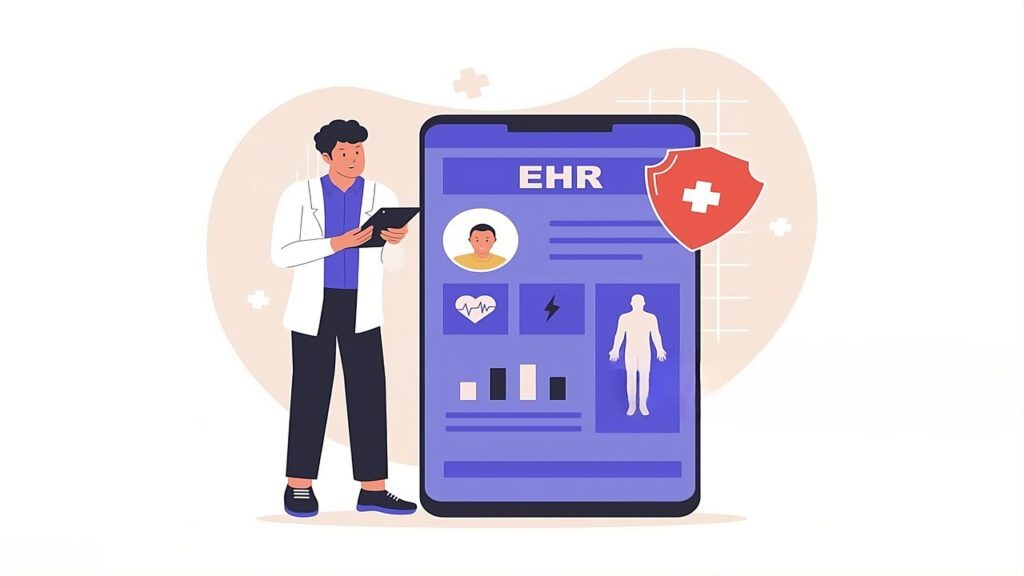
Making systems that handle electronic health records (EHR) is what EHR software development is all about.
An EHR is a computerized version of a patient’s paper chart that has all their health information, from diagnosis to prescriptions.
But it’s not only about storing data when you make EHR systems. It’s about making healthcare run more smoothly by giving doctors, nurses and other healthcare providers access to data right at the point of service.
This kind of access not only makes medical workflows more efficient, but it also improves patient outcomes and lowers the risk of expensive mistakes.
Healthcare providers may greatly improve patient care, cut down on mistakes and make sure they follow healthcare rules like HIPAA by developing EHR software development.
As the need for better healthcare solutions develops, so does the need for professional ehr development teams that can make systems that are safe and can grow with the business.
We’ll show you the important actions you need to take to construct an EHR system in this guide. Whether you’re figuring out how to build an ehr system or upgrading an existing one, this guide will help you through the complicated process of designing ehr computer software, covering everything from planning to implementation and maintenance.
Table of Contents
ToggleWhy EHR Development is Crucial for Healthcare Organizations in EHR Software Development
Digital technology is quickly changing the healthcare industry, and EHR software development is a big part of this change.
Recent reports on healthcare IT say that firms that use strong EHR systems can see their operations become up to 30% more efficient and their patients become much happier.
Here’s why it’s important to make EHR software:
1. More efficient:
EHR systems automate a lot of administrative duties, which cuts down on the time spent on paperwork and data entry by hand. This efficiency leads to faster patient throughput and better utilization of staff time, which increases profit margins.
2. Safety and Accuracy:
Putting all patient data in one place cuts down on mistakes. Correct health records make medical decisions safer and cause fewer bad events, which directly affect the quality of care.
3. Data Accessibility:
EHR systems make sure that healthcare providers can get patient information right away, no matter where they are, whether it’s in a clinic, a hospital or a remote care environment. This ability to work together is very important in today’s healthcare.
4. Compliance with regulations:
EHR systems are made to follow HIPAA and other rules, which protects private patient information and keeps the company from having to pay for compliance violations.
Healthcare businesses can not only improve their processes by hiring experts in ehr development, but they can also save money in the long run by lowering administrative costs and better allocating resources.
TIP: If you choose an EHR system with a scalable architecture, your platform will grow with your business. This will save you money on reworks and make it easy to support your growing healthcare operations.
Key Features of an EHR System for Effective EHR Software Development
A good EHR system is more than just a place to store files. It needs to include strong, easy-to-use features that make healthcare processes easier and better for patients.
| Key Feature | Description | Business Benefit |
| Patient Health Records | Stores demographics, medical history, allergies, medications, lab results | Reduces errors and speeds clinical decisions |
| Clinical Decision Support | Alerts and recommendations based on patient data | Improves quality of care and outcomes |
| Scheduling & Appointment Management | Enables efficient booking and reminders | Cuts no-shows, optimizes resource use |
| Electronic Prescriptions | Send prescriptions directly to pharmacies | Speeds treatment, reduces errors |
| Data Security & Compliance | Implement encryption, access controls, audit trails | Ensures HIPAA compliance, avoids penalties |
| Reporting & Analytics | Tracks outcomes, operational efficiency and compliance | Supports cost cutting and strategic planning |
All these elements help improve ROI by making operations more efficient, lowering the number of expensive mistakes and making patients happier.
Key Steps for EHR Software Development and How to Build an EHR System
To make a good EHR system, you need a clear plan. Here are the most important phases to take your ehr development project from idea to use.
| Step | Description | Importance |
| 1. Planning & Requirements Definition | Identify users, needed functionalities and data scope | Sets clear project goals and avoids scope creep |
| 2. Technology Selection | Choose scalable, secure, interoperable tech stack | Ensures long-term system performance and growth |
| 3. Hiring the Right EHR Developer | Find experienced developers with healthcare domain expertise | Minimize risks and speeds development |
| 4. Development & Implementation | Design architecture, develop features, integrate systems | Build a functional, user-friendly system |
| 5. Testing & Maintenance | Conduct rigorous testing and ongoing support | Ensures security, reliability and continuous improvement |
Step 1: Plan and write out what your EHR system needs to do
Before you start coding, make a list of the things your EHR system needs to do.
Make it clear:
- who will utilize it: a hospital, clinic or network?
- What aspects are most important?
- What kinds of patient data need to be included?
This foundation makes sure that development work is in line with real-world healthcare needs, which cuts down on expensive revisions later. This is an important step if you want to know how to build an ehr system properly.
Step 2: Picking the Best Technology for Your EHR System
Your technology stack needs to be able to:
- Scalability: Cloud-based or modular architecture lets your system grow as your business does.
- Security: Encryption, authentication and following HIPAA rules keep private patient information safe.
- Interoperability: Using standards like HL7 and FHIR makes it easier for other healthcare systems to work with yours.
Step 3: How to Look for and Hire the Best EHR Developer
Hiring the proper ehr developer is very important for the success of your EHR software development.
. Here are the things you should focus on:
- Experience in Healthcare: Developers that have worked on EHR projects before knowing the rules and processes in healthcare. This lowers the chance of having to deal with compliance problems and expensive redevelopment.
- Technical Proficiency: Make sure that applicants are knowledgeable in cloud computing, database management, security protocols and interoperability standards like HL7 and FHIR.
- Proven Track Record: Look at the portfolios or case studies of finished ehr computer software projects to see how well they can do the job.
- How to develop: An organized process that includes analyzing requirements, developing in stages and thorough testing makes sure that delivery is on schedule and of high quality.
Choosing the appropriate ehr developer can help you get a better return on your investment by avoiding common mistakes and making sure the software helps healthcare run smoothly.
Step 4: Making and using your EHR software
It’s time to develop your EHR system now that you’ve planned and put together the correct team.
Important tasks are:
- Architecture Design: Set up the database schema, system components and backend infrastructure. This base makes it possible to grow and stay safe.
- User Experience (UX) and User Interface (UI): Designing interfaces that are easy to understand and use makes people more likely to use them and lowers training expenses.
- Core Development: Writing the code for things like e-prescriptions, clinical decision support, patient health records and scheduling.
- System Integration: Your ehr computer software needs to work well with the hospital’s current information systems, labs, pharmacies and billing systems. This interoperability makes healthcare processes easier.
- Security Features: Use encryption, role-based access restrictions and audit logs to keep patient information safe and make sure you are following the rules.
To make sure that an EHR computer program is dependable and scalable, it must go through a good development and implementation phase that fits both clinical and administrative needs.
Efficient EHR systems can cut down on administrative labor by up to 40%, which lets healthcare providers spend more time with patients and less time on paperwork.
Step 5: Testing and Keeping Up Your EHR system
Testing is an important step in making EHR software. It makes sure that your system works right, is safe and runs smoothly before it goes live.
Pay attention to these testing parts:
- Functionality Testing: Make sure that services like making patient records, managing appointments and sending e-prescriptions work perfectly.
- Security Testing: Check encryption, user authentication and access rights to protect patient data and stay in line with HIPAA.
- Usability Testing: Check how easy it is for healthcare workers to utilize the system. EHR software development that is easy to use makes it more likely that people will use it and lowers the expense of training.
- Performance Testing: Make sure the system can manage a lot of patients and users at the same time without crashing or slowing down.
Deploy the system after it has been tested and make sure that workers have enough training and technical support. To address bugs, add new features and keep up with changing healthcare needs, ongoing maintenance is important.
Final Thoughts
Creating EHR software development is an important part of changing how healthcare is delivered. Well-designed EHR systems make things run more smoothly, make patients safer and lower costs. This leads to higher profit margins and return on investment (ROI) for healthcare businesses.
To make a good EHR system, you need to plan carefully, pick technologies that can grow and are safe and hire ehr developers who know a lot about the healthcare field. Adding important features like clinical decision assistance, scheduling and strong security means ensuring that the system works for both providers and patients.
Regular testing and maintenance make sure that your EHR system is always dependable, compliant and able to keep up with changes in healthcare. If you follow the steps in this article, you will be able to create an EHR system that improves care and makes operations run more smoothly.


